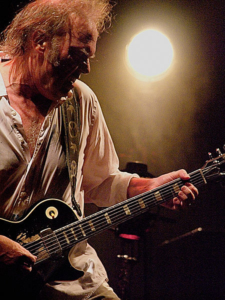I was in the middle of the Midwest, on the sixth floor of a high-rise dormitory on the campus of a huge state school, when the invasion of Iraq began. My roommate was almost always at the gym, leaving me with unencumbered access to his television. With a triple cheese pizza pooling grease onto my clothes, I watched American bombs shudder and bloom in obscene flashes. I kicked off my shoes and took another bite. Buildings shook; the sky was streaked with exotic lights. I’m sure there were voices accompanying the explosions — probably the same brand of empty, idiotic, banter that you now hear if you’re watching the Olympics, a combination of banal perceptions, occasional factual assistance, and almost surreal personal interjections. It’s filler, so that you don’t have to confront the image in silence.
But I wasn’t interested in straight commentary, so I put my headphones on and listened to Neil Young. The song was “Down By The River,” and I listened to it on repeat. A building would explode on my television and in my ears Young was half singing, half whispering his spectral confession of pointless violence. Young sings about a woman who drags him “over the rainbow,” over the precipice of logic and reason, where you experience raw passion for the sometimes ecstatic, sometimes malevolent, thing that it is. This woman is a figurehead of desire, holding so much power over the singer that she has to be destroyed. He takes her down to the river and shoots her.
The river in that song, one of two long, largely instrumental songs on Young’s second solo album, Everybody Knows This is Nowhere, is the Great American River, where everything comes from and where everything eventually ends up. It’s the same river that Huck and Jim escaped down, the same river in which backwoods Christians, chanting in white robes, meander down to the banks of to get baptized in its absolving current. It was the river on the television, the Tigris, its dark water reflecting American manufactured munitions exploding indiscriminately across Iraq. I fell asleep in my folding chair, grease stains patterning my t-shirt. I must have looked like a murder victim.
It wasn’t just the words of the song that made it fit the violence. Young’s voice, always strained, always seeming to be reaching for more than he can say or understand, commands as much attention as his words. It’s a voice that has been run through a thrasher, soaked in booze, shot, buried, dug up, reanimated, and propped on stage to tell us about what kind of weird visions it had seen on the other side. It’s the voice of someone who died in a car crash. It’s the voice of someone who died for love, knowing full well how stupid and pointless such an action is. It’s the voice of someone who is appalled by violence, but also knowing full well how capable he is of committing horrific acts. Sure, Neil Young was born in Canada, but it’s an American voice, speaking about American violence and the American experience.
In songs like “Southern Man” or “Ohio,” he sings about violence committed and perpetuated by the state, of injustice that so many hypocritically tolerate, so long as it comes from an official source. In “Cortez The Killer” and “Powderfinger” he sings about the original sins of colonization. In “Tonight’s The Night,” which opens, closes, and provides the title of his seventh official solo album, he sings about the violence we commit against ourselves — a particularly American style of self-destructive excess, murder in it’s own way. In the underrated song “Revolution Blues” he not only references the Manson killings, but seems to briefly embody their originator. We’re often led to believe that violence is committed in response to something, but in “Revolution Blues” Young captures the pathetic brand of violence that so many Americans — not just serial killers — are willing to commit for no other purpose than to create a narrative for themselves. True believers, we’re always ready to kill other people to become who we think we are.
Only a few years after watching the bombs fall on my roommates television, I was in Iraq myself. The soundtrack of my war was always Young. No other voice was so touched by the violence it was itself participating in.
In Young’s songs we see this pattern of violence: a pattern that has been apparent in our national fabric for hundreds of years. A pattern that perpetuates, replicates, and expands itself, aided by both those who would use it to achieve their own ends and those who seem to use it just “because it’s there.” A pattern that occasionally appears to recede, but that always seems to reappear without warning, as it did nearly two weeks ago in Aurora, CO. There we were reintroduced to the monster who sees himself as somehow wronged, waging a one-man war against the society he thinks has injured him. The lone actor who becomes enthralled by dark visions, feeling hemmed in by his own sense of victimhood until things hit a violent crescendo. The dream is over, and as we slide further and further into an apocalyptic sense of decline, at least there will be a voice to narrate the horror.
This post may contain affiliate links.









